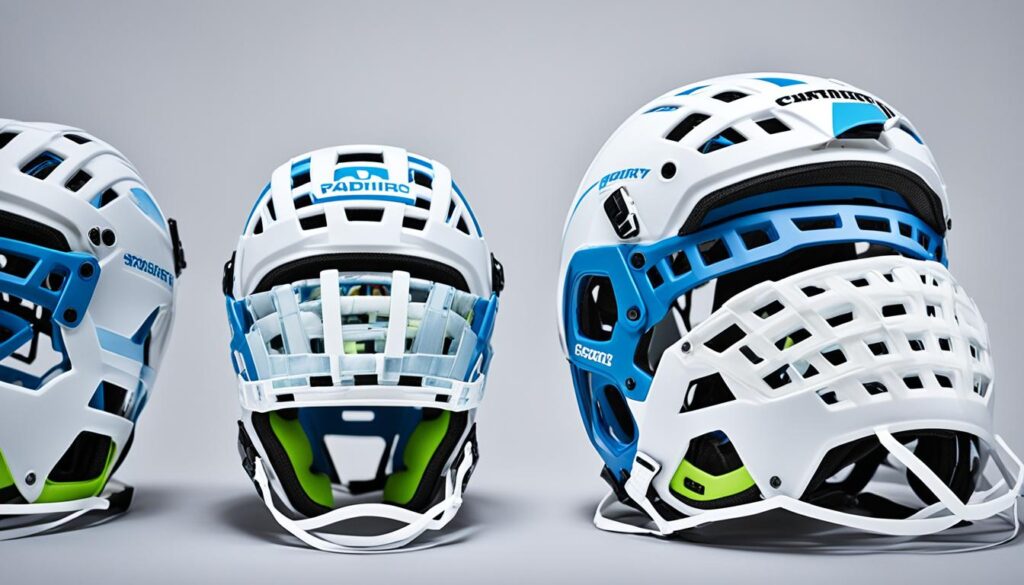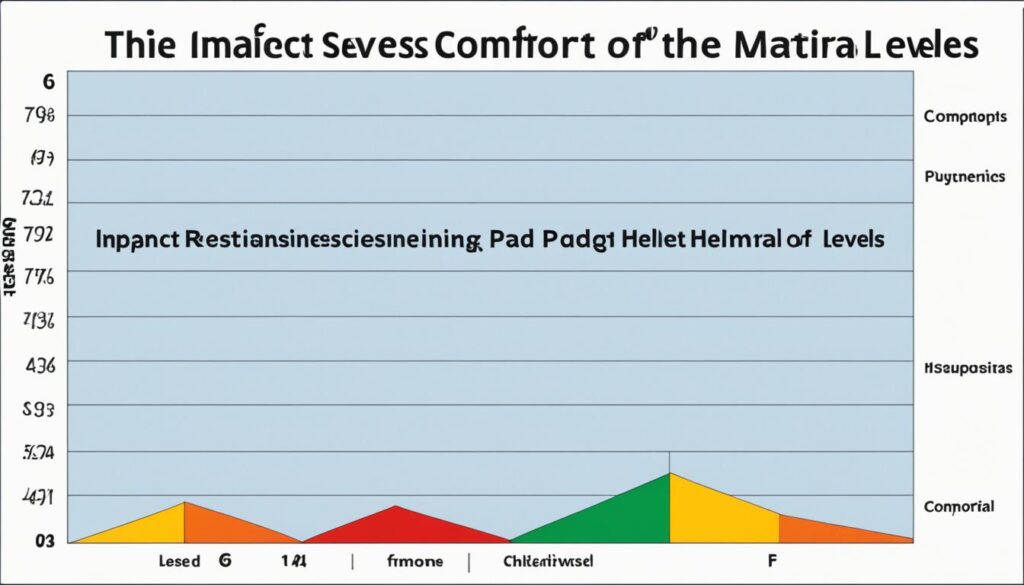
When it comes to choosing the best helmet for maximum safety and comfort, many factors come into play. However, one key element that often goes overlooked is the padding material inside the helmet. Have you ever wondered which helmet padding materials provide the best impact absorption and head protection? Are there specific materials that offer superior comfort without compromising safety? In this article, we will explore the best helmet padding materials currently available, delving into their features, benefits, and performance. By the end, you’ll have a clear understanding of which materials to look for when selecting a helmet that offers both safety and comfort.
Key Takeaways:
- Choosing the right helmet padding material is crucial for safety and comfort.
- Helmet padding materials play a vital role in impact absorption and head protection.
- There are various popular helmet padding materials available on the market.
- Testing and performance data help assess the effectiveness of helmet padding materials.
- Comfort and durability are important factors to consider when selecting helmet padding materials.
Helmet Foam Technology: A Key Element of Helmet Padding
Helmet foam technology is a vital component of helmet padding, playing a crucial role in absorbing and dissipating impact forces during collisions or falls. One popular type of foam used in helmets is expanded polystyrene (EPS). EPS foam, known for its lightweight and durable properties, offers excellent impact absorption capabilities. Its ability to effectively manage impacts makes it a preferred choice for helmet manufacturers.
Another innovative foam technology used in helmets is the multidirectional impact protection system (MIPS). MIPS utilizes a slip-plane design that reduces rotational forces during angled impacts, enhancing overall impact management. This advanced technology ensures improved energy management, providing an additional layer of protection to the wearer.
By incorporating helmet foam technology like EPS and MIPS, manufacturers are able to enhance the overall safety of helmets. These foam technologies have revolutionized impact absorption, reducing the risk of head injuries during accidents or high-impact activities.
Popular Helmet Padding Materials on the Market
When it comes to choosing the right helmet, the padding material plays a crucial role in providing comfort and safety. Various popular helmet padding materials are available on the market, each offering unique advantages.
- Memory foam: Memory foam is a popular choice due to its ability to conform to the individual user’s skull, creating a secure and comfortable fit. It provides excellent impact absorption and helps distribute the force of impact.
- Micro lattice pads: Micro lattice pads are known for their exceptional comfort and performance in terms of ballistic and blunt impacts. The unique lattice structure absorbs and dissipates impact energy efficiently.
- Comfort plus pads: These pads are designed specifically to enhance comfort during extended use. They offer a combination of cushioning and ventilation, ensuring a cool and comfortable fit.
- EPIC AIR pad system: The EPIC AIR pad system utilizes advanced foam technology to provide optimal comfort and stability. It offers adjustability options to achieve a personalized fit.
- Seven Pad BLU® Kit: The Seven Pad BLU® Kit features multi-density foam pads strategically placed to provide maximum protection and comfort. The kit allows for customization to fit various head shapes and sizes.
- EPP pad: EPP (Expanded Polypropylene) pads are widely used in helmets due to their excellent impact absorption properties. They are lightweight, durable, and can withstand multiple impacts without losing their protective capabilities.
- Foam-based pads: Foam-based pads come in various forms and densities. These pads offer a good balance between comfort and impact absorption, making them a popular choice for many helmet manufacturers.
These popular helmet padding materials provide a range of options to meet individual preferences and requirements. It’s important to consider factors such as fit, impact protection, and overall comfort when selecting the right padding material for your helmet.
Testing and Performance of Helmet Padding Materials
The performance of helmet padding materials plays a vital role in ensuring the effectiveness and protection they provide to the wearer. It is essential to consider the testing and performance data of the padding materials to make an informed decision about their reliability and suitability.
One significant aspect of testing is back-face deformation, which measures the force transmitted to the head during impact. This testing helps evaluate how effectively the padding material absorbs and dissipates force, reducing the risk of injury in the event of an accident or collision.
A crucial element is the ability of the padding material to handle blunt impacts. By analyzing blunt impact testing data, manufacturers can assess how well the padding material absorbs and mitigates impact forces from various angles.
When choosing helmet padding materials, considering their testing data and performance capabilities is essential for ensuring safety and comfort. High-performing padding materials can provide excellent pad performance, reducing the risk of severe head injuries.
“Testing and performance data provide valuable insights into the impact absorption capabilities and overall safety of the padding materials.”
Benefits of Testing and Performance Data:
- Analyze impact absorption capabilities
- Evaluate effectiveness in reducing head injuries
- Assess back-face deformation during impact
- Evaluate performance in mitigating blunt impacts
To better understand the implications of testing and performance data, let’s look at an example. One popular helmet padding material underwent rigorous testing, including back-face deformation and blunt impact testing. The testing data revealed a significant reduction in the force transmitted to the head, indicating that the padding material effectively absorbs and disperses impact forces, minimizing the risk of injury.

Helmet Padding and Comfort for Extended Use
When it comes to helmet padding, comfort is crucial, especially for extended use. Helmet padding materials, such as comfort plus pads and EPIC AIR pad systems, are specifically designed for all-day use, ensuring optimal comfort and stability.
These padding materials offer adjustability and customization options, allowing each individual user to achieve a snug and comfortable fit. The adjustability feature ensures that the helmet padding adapts to the unique shape of the wearer’s head, providing a secure and personalized fit.
Moreover, moisture-wicking fabric is often incorporated into helmet padding materials. This fabric helps keep the head dry by wicking away moisture and preventing discomfort due to sweating. It ensures that the padding remains breathable, even during intense physical activities.
Temperature regulation is another aspect to consider when selecting helmet padding materials. Some padding materials facilitate airflow, allowing heat to dissipate and preventing excessive heat buildup within the helmet. This feature ensures that the wearer remains cool and comfortable, even in hot weather conditions or during strenuous activities.
The combination of adjustability, customization, moisture-wicking fabric, and temperature regulation in helmet padding materials contributes to an enhanced level of comfort, making them suitable for all-day use.
Durability and Longevity of Helmet Padding Materials
The durability and longevity of helmet padding materials play a crucial role in ensuring the ongoing safety and performance of your helmet. High-quality padding materials, such as micro lattice pads and memory foam, are designed to offer long-term protection by maintaining consistent performance over time. These materials are built to withstand regular use and provide reliable impact absorption for extended periods.
However, it is important to note that helmet padding will inevitably experience wear and tear from regular use or impacts. This can result in worn-out padding, compromising its effectiveness in providing optimal protection. Therefore, regular replacement of worn-out padding is essential to maintain optimal safety levels.
Manufacturers provide recommendations for when to replace helmet padding to ensure compliance with safety standards and the ongoing effectiveness of the padding material. It is crucial to follow these guidelines and promptly replace worn-out padding to uphold the safety standards established for your helmet.
Compliance with Safety Standards for Helmet Padding Materials
When it comes to selecting helmet padding materials, compliance with safety standards is of utmost importance. Regulatory bodies have established these safety standards to ensure that the padding materials used in helmets meet specific performance criteria, guaranteeing the highest level of safety and protection.
Choosing padding materials that have undergone rigorous testing and obtained necessary safety certifications is crucial. Examples of such certifications include those set by the Department of Transportation (DOT) and the Snell Memorial Foundation. These certifications ensure that the padding materials meet the required safety standards and provide reliable protection in the event of an impact or collision.
“Safety certifications and compliance with helmet safety standards are paramount in ensuring the effectiveness of helmet padding materials.”
By selecting helmet padding materials that comply with safety standards, you can have confidence in the quality and performance of your helmet. These standards serve as a guarantee that the padding materials have been thoroughly evaluated and tested to meet the necessary safety requirements.
Impact of Helmet Padding on Different Helmet Types
The impact of helmet padding plays a crucial role in the safety and performance of different helmet types. Whether you’re engaging in cycling, motorcycling, skateboarding, skiing, or climbing, each activity requires specific padding materials to ensure optimal protection.
Cycling helmets, for example, must have padding that can effectively absorb and dissipate the impact forces that may occur during falls or collisions. Motorcycling helmets also require specialized padding to provide ample protection against high-speed impacts. Similarly, skateboarding helmets need padding materials that can withstand the unique impact scenarios associated with skateboarding tricks and maneuvers.
When it comes to specialized helmets designed for skiing or climbing, the padding material requirements become even more specific. These helmets often feature padding that can withstand impact forces from rocks or ice, providing the necessary protection for these activities.
It is essential to consider the impact of helmet padding on different helmet types and choose the appropriate materials based on the intended use and safety requirements of the helmet. By selecting the right padding materials, you can ensure optimal safety and performance during your chosen activity.
Choosing the Right Padding Materials
When selecting helmet padding materials, consider the specific impact scenarios associated with your chosen activity. Research and choose padding materials that are designed to address these specific needs. Look for helmets that meet safety standards and have undergone rigorous testing, ensuring their effectiveness in protecting against the impacts typical of your activity.
For example, if you enjoy cycling and are looking for a helmet with impact-absorbing padding, consider those made with advanced foam technologies such as expanded polystyrene (EPS) or the multidirectional impact protection system (MIPS). These padding materials are specifically designed to enhance energy management and provide superior protection during cycling accidents.
Similarly, if you are into skateboarding or motorcycling, helmets with specialized padding materials that offer excellent impact absorption properties are crucial. These might include materials such as memory foam, micro lattice pads, or foam-based pads, which are known for their ability to protect against blunt impacts and provide optimal comfort.
Choosing the right padding materials for your helmet is not just about safety, but also about comfort and performance. Different helmet types require specific padding materials that can withstand the impact forces associated with the activity while providing a comfortable fit for extended use.
- Activity-specific helmets – Remember that specialized helmets, such as those used for skiing or climbing, may have unique padding material requirements due to the specific impact scenarios associated with these activities.
- Safety and performance – Ensure the padding materials you choose meet safety standards and have undergone testing to ensure their effectiveness in protecting against the types of impacts you may encounter.
- Comfort for extended use – Look for padding materials that offer adjustability and customization options to ensure a snug and comfortable fit, especially for activities that require all-day use.
By understanding the impact of helmet padding on different helmet types and selecting the appropriate materials, you can enhance your safety, comfort, and overall performance while enjoying your favorite activities.
Conclusion
In conclusion, when it comes to helmet safety and comfort, selecting the right padding materials is of utmost importance. The chosen helmet padding material should possess excellent impact absorption properties, providing maximum protection during activities. Comfort and stability are equally important, ensuring a secure and snug fit for the wearer. It is crucial to choose padding materials that comply with safety standards established by regulatory bodies, guaranteeing the highest level of safety and protection.
Considerations such as helmet foam technology, testing and performance data, comfort for extended use, durability and longevity, compliance with safety standards, and the impact of padding on different helmet types should be thoroughly evaluated. By selecting the appropriate helmet padding materials, you can enhance your overall safety, while also enjoying a comfortable and secure fit during your activities.
Remember, a well-chosen helmet padding material not only provides impact absorption but also plays a crucial role in ensuring your safety and comfort. So, whether you are cycling, motorcycling, skateboarding, or engaging in any other activity that requires head protection, make an informed decision and choose the best helmet padding materials that prioritize safety, comfort, and compliance with safety standards.
Recommended

Meet James Smith, affectionately known by friends as ‘Biker Smith’, your go-to expert at ‘Best HD Helmet Camera’. At 35, living in the USA, James embodies the spirit of adventure. His life is a thrilling ride, powered by his Harley Davidson Softail and BMW S 1000 RR, with his girlfriend as his favorite travel companion. A software developer by profession, James’s heart beats for the open road, making him a full-time traveler at heart. His passion for biking and technology merges seamlessly on this platform. Recognizing a gap in discussions around helmet cameras, he founded this blog to educate and inspire fellow enthusiasts. His mission? To elevate your riding experience with the best HD helmet camera insights, backed by firsthand experiences, rigorous testing, and a genuine love for the ride. Trust James to guide you through the world of helmet cameras, where quality, innovation, and safety ride together.